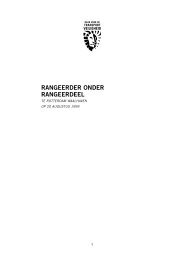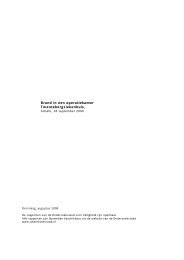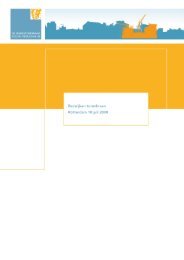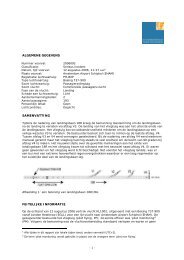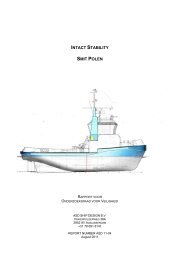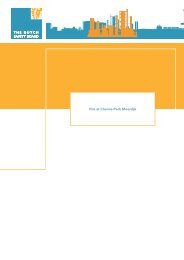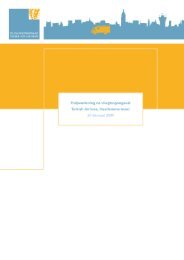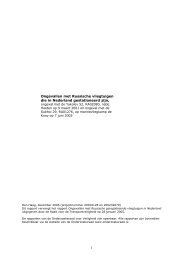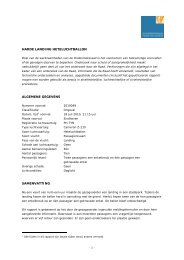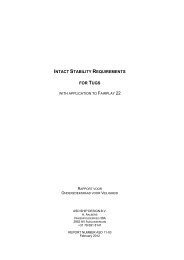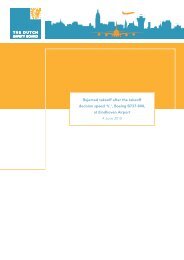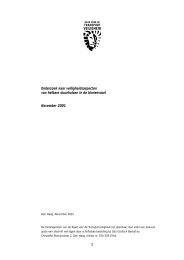Breaking of mooring lines whilst mooring m.v. Edisongracht between ...
Breaking of mooring lines whilst mooring m.v. Edisongracht between ...
Breaking of mooring lines whilst mooring m.v. Edisongracht between ...
Create successful ePaper yourself
Turn your PDF publications into a flip-book with our unique Google optimized e-Paper software.
ANNEX 1: GLOSSARYBareboat charterBoatmenCall signCall signCentre leadClassification societyFlag stateVessel chartering arrangement where the people chartering pay aspecific sum for just the vessel without crew. All additional costssuch as those related to insurance and crew are borne by thepeople chartering the vessel.Quayside personnel who assist when <strong>mooring</strong> and un<strong>mooring</strong> <strong>of</strong>ocean-going vessels in a port.The radio call sign <strong>of</strong> a vessel that is used to identify from whom aradio call originates. The call sign for Dutch ocean-going vesselsstarts with the letters PA to PI followed by two letters.The radio call sign <strong>of</strong> a vessel that is used to identify from whom aradio call originates. The call sign for Dutch ocean-going vesselsstarts with the letters PA to PI followed by two letters.Central opening in the upright wall -the bulwark- <strong>of</strong> the foredeckfor passing through <strong>mooring</strong> <strong>lines</strong>.Organisation that determines the rules regarding the build andequipment <strong>of</strong> vessels and supervises this through surveys.Classification societies may be recognised by flag states toperform work for certifying purposes on behalf <strong>of</strong> the flag state.State to which a vessel belongs and is, therefore, entitled to wavethe relevant flag.Forecastle deckThe deck where the <strong>mooring</strong> and anchoring gear <strong>of</strong> the fore is setup.Gross tonnage (GT)Vessel size based on which it is determined which legislationapplies to a vessel.IMOInternational Maritime OrganizationIMO number Unique international vessel identifying number consisting <strong>of</strong> 7digits that is allocated when newly built and does not changewhen registration changes.ISMInternational Safety ManagementKnotOne knot is one sea mile per hour (1.852 km/hour)KVNRRoyal Dutch Shipowners AssociationLOA (Length overall)Maximum length <strong>of</strong> the hull <strong>of</strong> a vessel measured over the water.LPP (Length <strong>between</strong>perpendiculars)Length <strong>between</strong> perpendiculars – length size <strong>of</strong> a vessel based onwhich it is determined which legislation applies to a vessel.LTLocal timeMaximum draughtMaximum allowed draught up to where a vessel may be loaded. Adistinction is made into summer, winter and tropical areas as wellas fresh and salt water for certification purposes.Minimum <strong>Breaking</strong> Load(MBL)Minimum breaking load that can be resisted by a <strong>mooring</strong> linebefore it breaks.Mooring buoysBerth where the vessel is moored <strong>between</strong> <strong>mooring</strong> buoys withoutany further contact with other port <strong>mooring</strong> facilities.Nautical mile1,852 kmNet tonnage (NT)Vessel size for the loading capacity.- 18 -



